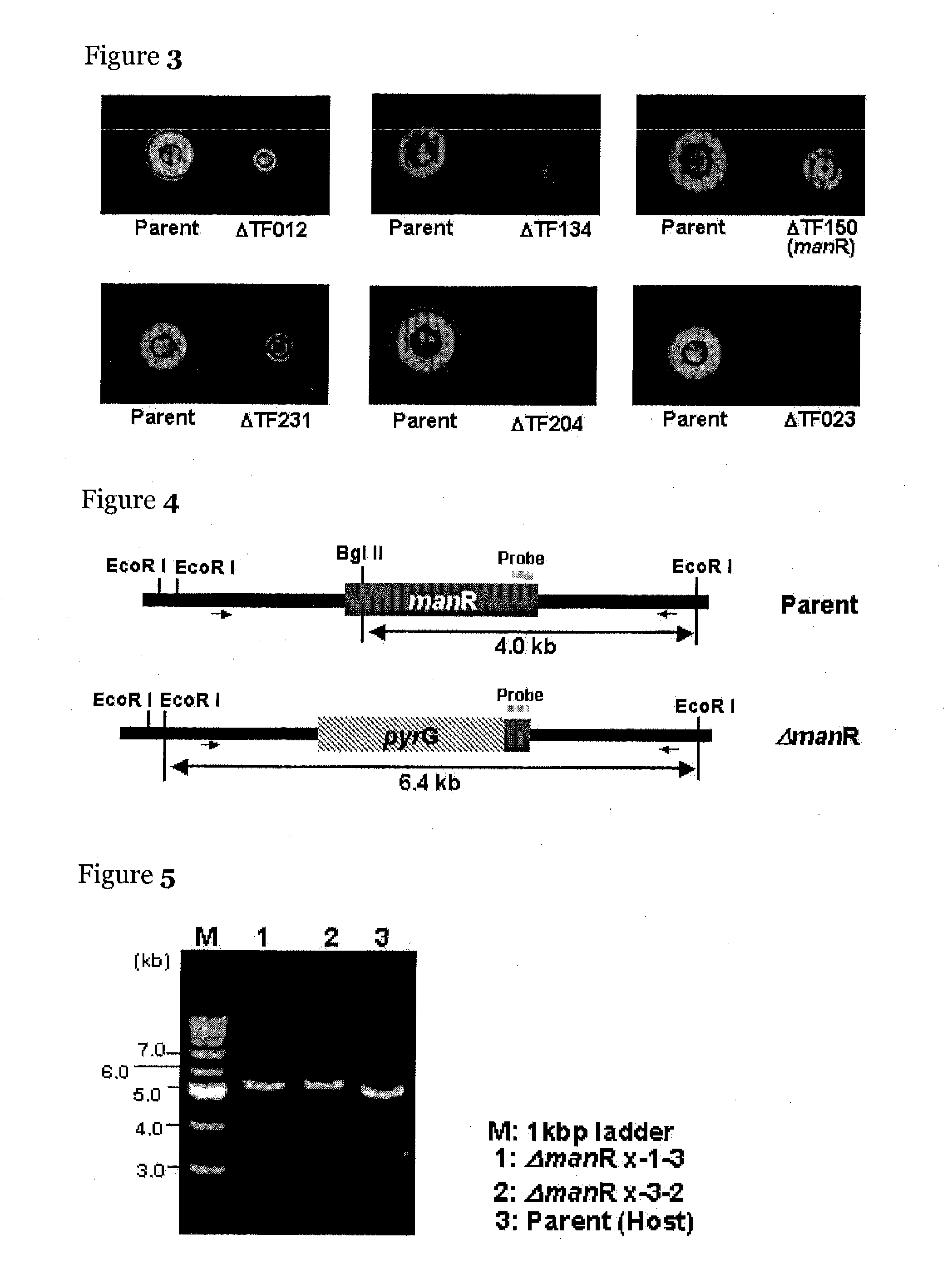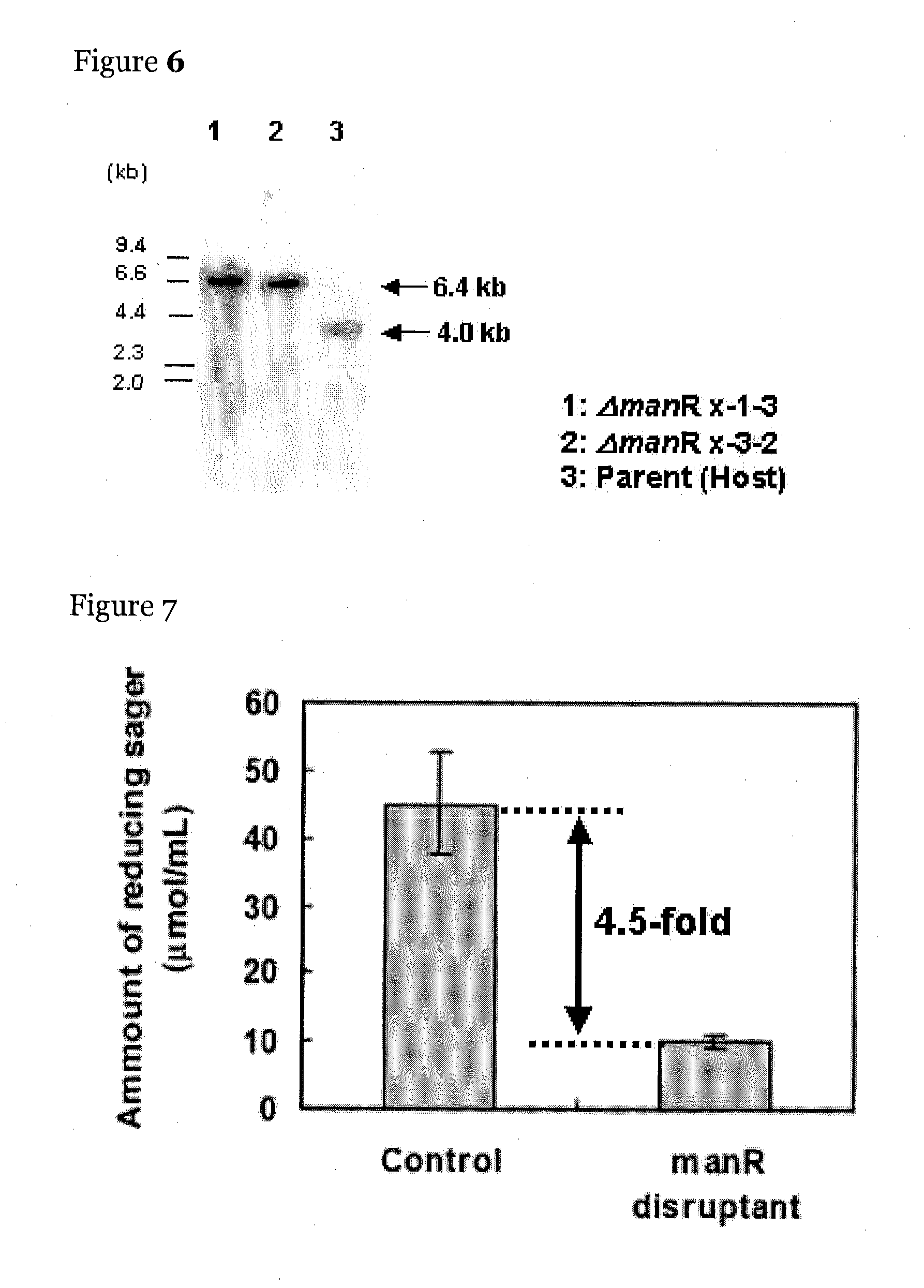Transcription regulatory factors for mannanases or cellulases, and genes for the transcription regulatory factor
a transcription regulatory factor and transcription regulatory factor technology, applied in the field of transcription regulatory factors for mannanases or cellulases, can solve the problems of undiscovered transcription regulatory factors for mannanases and investigation has not been carried out to date, and achieve the effects of improving transcription regulatory factors, enhancing the and efficient production of mannan hydrolases or cellulose hydrolases
- Summary
- Abstract
- Description
- Claims
- Application Information
AI Technical Summary
Benefits of technology
Problems solved by technology
Method used
Image
Examples
example 1
Screening of Transcription Regulatory Factor (manR) of Koji Mold
[0103]The genome sequence of a koji mold, an Aspergillus oryzae RIB40 strain, was determined in 2005 (Nature, 438: 1157, 2005), and the information thereon is available from DOGAN database (http: / / www.bio.nite.go.jp / dogan / MicroTop?GENOME_ID=ao). Before, the present inventors manually annotated the transcription regulatory factor gene based on this genome information and produced a library of transcription regulatory factor gene disruptants, the genes of which are comprehensively disrupted (5th International Aspergillus Meeting, No. 16, 2008, Edinburgh, UK).
[0104]The microorganism strains used in the production of the library of the transcription regulatory factor gene disruptants are an Aspergillus oryzae RkuN16ptr1 strain (Mol. Genet. Genomics, 275: 460, 2006; Biosci. Biotechnol. Biochem, 70: 135, 2006) and its derivative, Aspergillus oryzae RkuptrP2-1 5-FOA-resistant strain No. 2 (Appl. Environ Microbiol., 74: 7684, 2...
example 2
Method of Screening
[0119]Screening of the transcription regulatory factor was performed as follows. A sample to be tested was inoculated to a plate of a Czapek-Dox minimal medium (0.05% KCl, 0.2% NaNO3, 0.1% KH2PO4, 0.05% MgSO4, 0.001% FeSO4, and 2.0% agar) containing 1.0% glucomannan (manufactured by Megazyme) and was cultured at 30° C. for 3 days. After completion of the culture, about 8 mL of 0.25% Congo red was added to the plate for staining for 15 min, followed by washing the plate with about 8 mL of a 1.0 M NaCl solution for 30 min three times. After the washing, about 3 to 5 mL of 5.0% acetic acid was added to the plate, and the plate was left at room temperature for about 10 min to change the color of the Congo red to blue to detect halo formed by the extracellular mannanase activity. In this experiment, the control strain was used as a positive control. About 180 transcription regulatory factor gene disruptants were subjected to screening, and in six strains, a notable red...
example 3
Method of Producing manR Disruptant
[0121]The manR disruptant (TF150 disruptant) in the library of the transcription regulatory factor disruptants was produced by the following method. The present inventors anticipated by manual annotation that a transcription regulatory factor gene having one Zn2Cys6-type zinc finger motif lies between 545601 and 543115 in chromosome 8 SC010 of Aspergillus oryzae RIB40.
[0122]In the production of the library, a vector for gene disruption was designed using the genes that are expected to lie in this region as targets, and oligonucleotide primers represented by SEQ ID NOs: 7 to 12 were designed.
[0123]The vector for gene disruption was produced as follows. First, DNA fragments of the right and left arms (fragments R and L) for homologous recombination and of pyrG (fragment P) serving as a marker gene in transformation were amplified by a PCR method.
[0124]In the PCR, KOD plus (manufactured by TOYOBO), which has high accuracy, was used. The final concentr...
PUM
| Property | Measurement | Unit |
|---|---|---|
| temperature | aaaaa | aaaaa |
| temperature | aaaaa | aaaaa |
| temperature | aaaaa | aaaaa |
Abstract
Description
Claims
Application Information
 Login to View More
Login to View More - R&D
- Intellectual Property
- Life Sciences
- Materials
- Tech Scout
- Unparalleled Data Quality
- Higher Quality Content
- 60% Fewer Hallucinations
Browse by: Latest US Patents, China's latest patents, Technical Efficacy Thesaurus, Application Domain, Technology Topic, Popular Technical Reports.
© 2025 PatSnap. All rights reserved.Legal|Privacy policy|Modern Slavery Act Transparency Statement|Sitemap|About US| Contact US: help@patsnap.com



